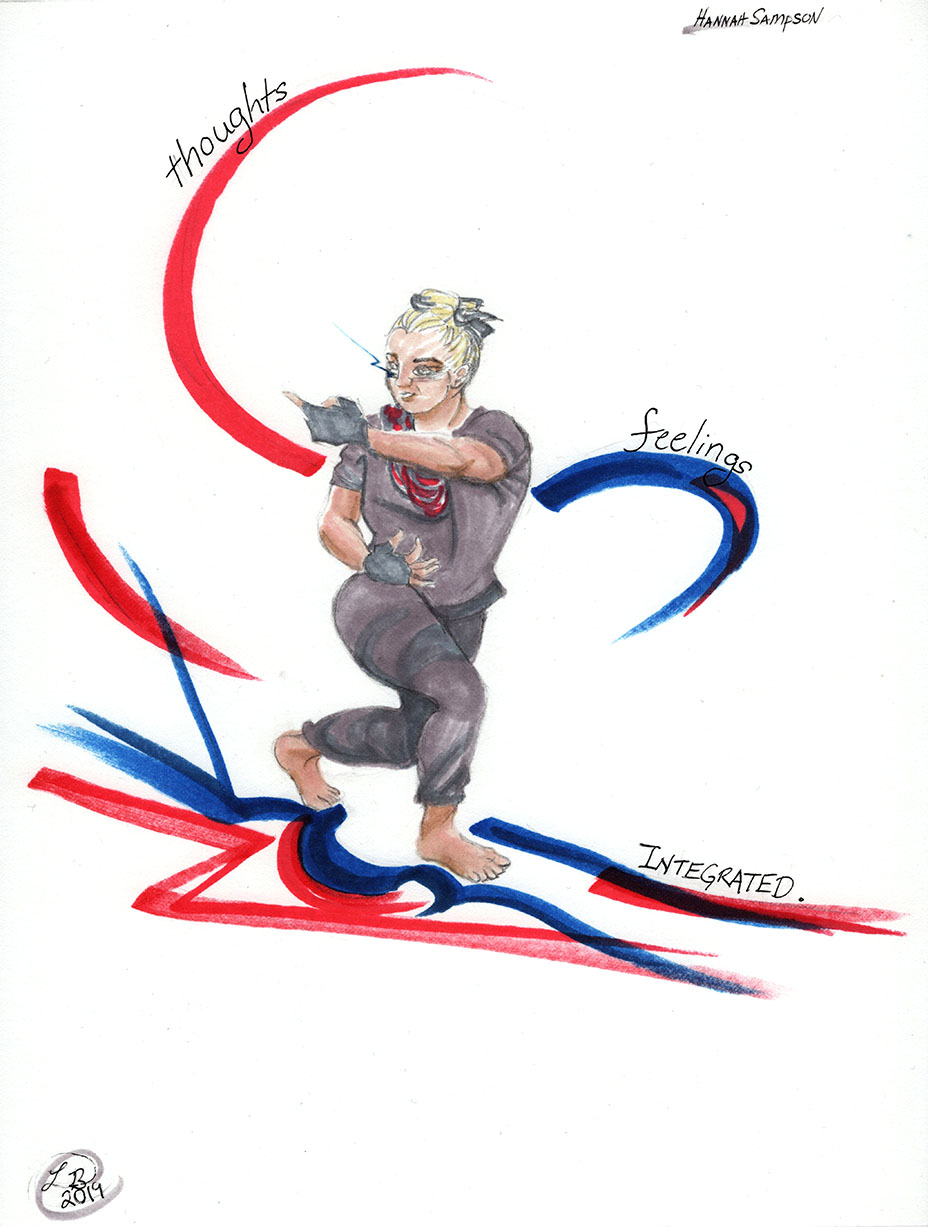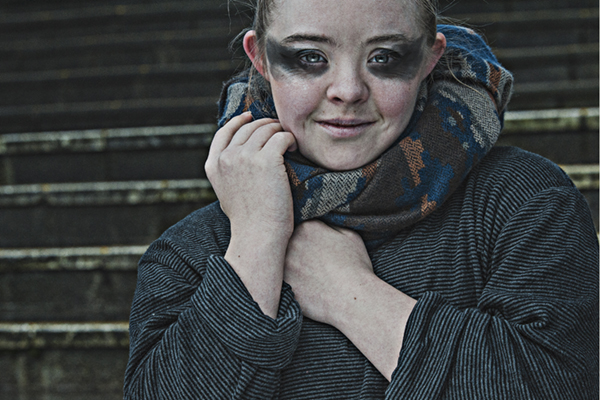Hannah Sampson: “How We Respect and Treat Each Other”
BY EMMALY WIEDERHOLT; ILLUSTRATION BY LIZ BRENT-MALDONADO
Hannah Sampson is a dancer with Stopgap Dance Company in the UK. She completed her BTEC (Business and Technology Education Council) certificate in performing arts at Kingston College. She was an original member of the Stopgap Youth Dance Group before joining Stopgap Dance Company in 2010 as a trainee. In 2012, she toured in the European Street Arts Festivals Tour Tracking and in the UK Cultural Olympiad outdoor tour SPUN Productions. In 2013, Hannah became part of Sg2 (Stopgap’s apprentice company) and, in 2016, she became a member of the main touring company.
Listen to the audobook recording of Hannah Sampson’s interview here!
To learn more about the Discussing Disability in Dance Book Project, visit here!
Image description: Hannah is depicted stepping forward on the diagonal, her legs in a deep bend. Her torso is twisted toward the other diagonal and her arms are held in front of her as if she is embracing something invisible. She is wearing all gray with theatrical eye makeup. Strokes of blue and red swirl around her along with the quotes, “thoughts,” “feelings,” “integrated.”
~~
How did you get into dance and what have been some highlights in your dance history?
I always loved to dance, and started taking ballet lessons from the age of five at Miss Virginia’s School of Ballet in Cobham, doing my grades through RAD [Royal Academy of Dance]. At secondary school, I studied for my GCSE [General Certificate of Secondary Education] in dance for two years. I really enjoyed the course because I got to learn about different choreographers and their work, such as Matthew Bourne’s Swan Lake and the work of Henri Oguike. I then went on to do a BTEC [Business and Technology Education Council] certificate from Kingston College in performing arts. It focused on a mix of theater and dance.
I did a few workshops with Stopgap Dance Company when I was younger, like age 13 or 14. While I was finishing school, I did some more workshops with them, getting to know everyone in the company. After finishing my BTEC, Stopgap took me on as one of their apprentice dancers. This was my dream come true. It was an important step to becoming a professional dancer because I learned how to travel on tour and how to teach mixed age youth groups. I also performed in a number of dance pieces. From there, I joined the main touring company.
The highlight of my dance career so far has been joining Stopgap as a professional dancer. I get to go on tour with my Stopgap family, to show our work and to teach children and young adults like myself.
How would you describe your current dance practice?
We work five days a week, and sometimes we work on the weekends as well. We usually take a company class, and it could be based on fitness, yoga or a contemporary dance form. We have different and unique dance styles in the company. If we have a dance piece we’re creating or practicing, we go over all the movement we do in the piece. Some days we teach workshops. Some days it’s a mix.
I get my movement from feelings and images. I use those as my inspiration to make movement. When I start moving, I work those thoughts into my routines.
When you tell people you are a dancer, what are the most common reactions you receive?
I’m not the kind of person who would go up to someone and say, “I’m a dancer.” If a person does see me perform, and they say, “I just saw you dance and you looked so beautiful out there,” I would take that in and say back, “Thank you.” But I wouldn’t just say, “My name is Hannah and I dance with Stopgap.” I would only mention it to someone who I know and feel comfortable talking with.
A lot of the time, when we are getting ready to perform a piece and we’re not in costume or makeup, we have people stop and watch us. We had a recent outdoor piece with a lot of people involved and watching us, and those people said, “Wow.”
When people do hear that I am a dancer, I think they are really interested. I’m not sure they understand that it is professional until they see us all perform. Those parents of children with Down syndrome or special needs love to see us perform. I have had a lot of people say I inspire them.
What are some ways people discuss dance with regards to disability that you feel carry problematic implications or assumptions?
It’s the wording people use that is more problematic. We are an inclusive dance company instead of a disabled company. As a company, we find it hard to explain the meaning of the word “inclusive.” We find that people zoom in and focus on the disability when that’s not what defines us as a company. It’s just a feature. We do use disability, but we’re not dragged down by it. People don’t understand that. We have dancers with and without disabilities. There are dancers with learning disabilities, like myself and one other dancer. And we have dancers who have physical disabilities as well. But it’s not focused on what we look like. In the company, everyone is seen as equal.
For reviewers, be honest and tell the truth as you see it. Review and write about our performance rather than focusing on the disability. A good review is based on what you see, not on the fact that we’re an inclusive dance company.
Do you believe there are adequate training opportunities for dancers with disabilities? If not, what areas would you specifically like to see improved?
I believe there are more opportunities now than when I first started, but we do need more. When I first started, there were barely any. Now, my friends are learning to dance and getting more opportunities to study dance or the performing arts. It would be great to see inclusive companies put on workshops all over the world. However, disabled dancers like myself might not be able to get jobs like nondisabled dancers can get. Stopgap puts on workshops for people with special needs which gives them the opportunity to dance and express themselves, but there are very few opportunities to dance at a professional level.
I always dreamt of working with a professional dance company but, if I hadn’t met Stopgap, things would be very different for me. The other dancer who is learning disabled and I require a bit more support than the other dancers. It’s how we respect and treat each other in the company.
Would you like to see disability in dance assimilated into the mainstream?
Yes, definitely. At the moment, Stopgap is now studied as part of the GCSE dance syllabus. Artificial Things, choreographed by Lucy Bennett for Stopgap Dance Company, is one of the six works featured on the GCSE Dance Anthology. Students study the performance and can come to our workshops, and then get more involved with inclusive dance.
We’ve also got a YouTube channel called Replay that gives people an opportunity to try out Stopgap’s company class, inclusive yoga, and Stopgap’s repertoire. We’ve got our youth groups where they might not have much experience in dance and want to learn more. The same with our older group. It’s an opportunity for them to have support from Stopgap to learn technique and skills.
This can only be a good thing. It’s important that companies adapt to help us integrate. When I did my BTEC at Kingston College, the course would have been too much for me with all the writing, so they adapted the course so that I could do it as a one-year BTEC certificate course, which was great for me.
What is your preferred term for the field?
Integrated. Stopgap is an integrated dance company because we’re a mix of disabled and non-disabled dancers coming together as one. If we draw a line of who we are, we become restricted. But we’re open. This is why I prefer “integrated,” because it’s more open.
In your perspective, is the field improving with time?
Basically, yes, just like I said about it becoming more mainstream.
Hannah Sampson, Photo by Chris Parkes
Image description: Hannah is pictured close to the camera from the chest up. She is looking directly at the camera in dramatic black eye makeup that swooshes from below her eyes to her temples. She is wearing a big printed scarf and a striped shirt, and her hands delicately clutch her scarf.
~~
To learn more about Stopgap Dance Company, visit www.stopgapdance.com.
To learn more about the Discussing Disability in Dance Book Project, visit here!


